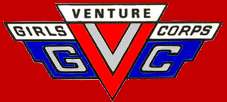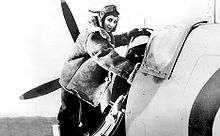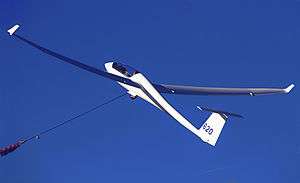Girls Venture Corps Air Cadets
| Girls Venture Corps Air Cadets | |
|---|---|
 | |
| Active | 1940 - Present |
| Role | Volunteer Youth Organisation |
| Headquarters | Sheffield |
| Commanders | |
| Corps Commandant | Yvonne McCarthy |
The Girls Venture Corps Air Cadets (GVCAC) is a voluntary uniformed youth organisation in the United Kingdom for girls aged between 11 and 20. It is a registered charity,[1] and is a member of The National Council for Voluntary Youth Services (NCVYS).[2] The current Corps Director is Brenda Layne, MBE, and the Corps Commandant is Yvonne McCarthy. The GVCAC receives no funding from the Ministry of Defence (MoD). All adult staff members are subject to security and Criminal Records Bureau checks.[3]
History
The GVC has its origins in 1940 as part of the National Association of Training Corps for Girls, this umbrella organisation was responsible for the Girls Training Corps (GTC), Girls' Nautical Training Corps (GNTC) and Women’s Junior Air Corps (WJAC).[3]
First woman to break sound barrier

Former Air Transport Auxiliary Pilot, Diana Barnato Walker became a pilot for the Women's Junior Air Corps (WJAC) shortly after the war, giving cadets training and air-experience flights to air-minded teenage girls to encourage them to enter the aviation industry. In July 1948, an aircraft that she was flying burst into flames at near White Waltham. Rather than bale out and lose the WJAC’s aircraft, she switch off the fuel and glided the aircraft back. In 1963 she undertook a flight in an English Electric Lightning, attaining 1,262 mph (Mach 1.65) in a two-seat T.4 trainer and thus became the first British woman to exceed the speed of sound.[4][5]
Girls Venture Corps
In 1964 the Girls Venture Corps replaced both GTC and WJAC. The previous year, the Girls Nautical Training Corps became more closely involved with the Sea Cadet Corps[3] and in 1980 became an integral part of the Sea Cadets and ceased to be a separate organisation.[6] The Girls Venture Corps had two wings corresponding to the former GTC and WJAC; it was common at this time for former GTC units to share premises with Army Cadet Force units and for former WJAC units to share premises with Air Training Corps units. From 1983 girls were accepted into the ACF and ATC, which caused many GVC cadets to transfer to their respective counterparts.[7] It was decided that the GVC would focus on air activities and in 1987 the organisation was renamed 'Girls Venture Corps Air Cadets'.
Activities

Duke of Edinburgh Award
The Duke of Edinburgh's Award Scheme is a voluntary, non-competitive programme of practical, cultural and adventurous activities for young people aged 14–25. The Award programme consists of three levels, Bronze, Silver and Gold. Each have differing criteria for entry and the level of achievement necessary to complete each award. Cadets who meet the age criteria can join the award scheme.
Each award is broken down into 4 areas (5 for gold) which participants must complete successfully to receive their award. These are:-
- Service
Helping others in the local community.
- Expeditions
Training for, and planning of a journey.
- Skills
Demonstrate ability in almost any hobby, skill or interest
- Physical Recreation
Sport, dance and fitness.
- Residential Project (Gold Award only)
A purposeful enterprise with young people not previously known to the participant.
Cadets are often encouraged to achieve the Bronze, Silver and Gold awards as they progress through their cadet careers. Some cadets aged 16 or over used to be able to participate in the Duke of Edinburgh's Millennium Volunteers Award, this has now been overtaken by another authority and it is currently being reviewed on whether or not cadets will be able to undertake it as it has a new structure.
The Award is widely recognised by employers as it helps demonstrate that award holders are keen to take on new challenges, have a higher level of self-confidence than their counterparts, have leadership qualities with the added experience of teamwork.
Aviation Award
There is opportunity for all Cadets within the GVCAC to undertake practical Gliding and Powered Flying this is underpinned by training courses in Aviation subjects and are an integral part of the Challenge Award as well as being an award within itself .[3]
- Air Discovery (from age 11 onwards)
- Basic study and practical experiments
- Air Ability (Ages 12–13) Introduction to:
- Air Traffic Control
- Weather
- Engines
- Flight and Navigation Theory
- Air Proficiency (Ages 13+)
- Air Traffic Control & Radio
- Meteorology
- Air Navigation
- Propulsion & Theory of Flight
- Air Brevet This gain this qualification a single specialist subject is studied:
- Aeronautical Engineering (Engines)
- Air Navigation
Challenge Award
The Challenge Award consists of drill and etiquette, service to the community, life skills, outdoor/adventure activities, interests/skills, and physical recreation sections.
Drill and Etiquette
The GVCAC, as a uniformed youth organization, sets itself and its members very high standards, including dress and behaviour. Drill (marching) is a vital part of encouraging teamwork, discipline, co-operation and self-confidence. Practicing drill is a means of instilling discipline and teamwork, it is also used in formal parades, for moving around military bases and moving cadets in a smart and orderly fashion. The Corps instills good manners and customs (Etiquette) into cadets behaviours this transfers into having respect for each other, their family and is often well received by prospective employers.
Outdoor/Adventure Activities
These include:
- Camping
- Expeditions
- Survival
- Orienteering
- Archery
- Wall Climbing
- Shooting
- Abseiling
- Canoeing
Physical Recreation
The GVCAC offers its several sporting activities and thus encourage its members to lead healthy lives.
- Skiing
- Pentathlon
- Walking
- Team Games
- Football
- Hockey
Other activities
GVCAC Cadets can also take part in the International Air Cadet Exchange (I.A.C.E), and Nijmegen Marches.
Flying and Gliding Scholarships
RAFA Flying Scholarship

The Royal Air Force Association each year invites applications from both ATC and GVCAC for a limited number of flying scholarships. In 2008 Nicole Pogmore from Rotherham was successful in being awarded an RAFA scholarship.[8]
Ducat-Amos Gliding Scholarships
In 2007 six grants were awarded to GVCAC Cadets which enabled attendance on a weekend course at a local gliding club. The scholarships were named after Air Commandant Barbara Ducat-Amos CB RRC (1921-2008), Director of Royal Air Force Nursing Service.[9]
Structure
The headquarters is situated in Tinsley, South Yorkshire, east of the Tinsley Viaduct at junction 34 of the M1 motorway, off the Tinsley Roundabout at the start of the A631. The Meadowhall Centre is nearby to the west.
Ranks
Cadet ranks
As well as learning new skills by working through the GVCAC syllabus, experienced cadets can be awarded a rank. The GVCAC allows its Cadets to take on responsibility and leadership as Non-commissioned Officers or NCOs.
| Insignia |  |  |  |  |  |  | |
|---|---|---|---|---|---|---|---|
| Rank | Cadet | Leading Cadet | Cadet Lance Corporal | Cadet Corporal | Cadet Sergeant | Cadet Unit Sergeant | Officer Cadet |
Staff ranks
| Insignia |  |  |  | |||
|---|---|---|---|---|---|---|
| Rank | Potential/Acting Section Officer | Section Officer | Assistant Unit Officer | Unit Officer | Senior Officer | Honorary Corps Commandant |
Uniform
- Unit
- Cap
- Black Tie
- Blue shirt
- Blue RAF jumper
- Brassard
- Lightweight green trousers
- Black shoes
- Stable belt
- Formal (As above but with)
- RAF skirt
- Camp uniform
- Blue shirt or polo shirt
- Navy blue sweatshirt
- Lightweight green trousers
- Black trainers
Unit locations
| Region 1 | Region 7 | Region 9 | Region 11 | Region 12 | Region 18 | Region 25 |
|---|---|---|---|---|---|---|
| South Shields (Tyne & Wear) | Huntingdon (Cambridge) | Culver (Isle of Wight) | RAF Marham (King's Lynn, Norfolk) | Feltham (Middlesex) | Hednesford (Staffordshire) | Ollerton (Nottinghamshire) |
| Gateshead (Tyne & Wear) | St Ives (Cambridge) | Ryde (Isle of Wight) | King's Lynn (Norfolk) | Greenford (Middlesex) | Smethwick (Oldbury, West Midlands) | Rotherham (South Yorkshire) |
| Wisbech (Cambridge) | Newport (Temporary Closed) | Southend (Leigh on Sea, Essex) | Stafford (Staffordshire) | Sheffield (South Yorkshire) | ||
| Yaxley (Cambridge) | Walsall (West Midlands) | Wigston (Leicestershire) |
See also
External links
References
- ↑ http://www.charitiestrust.org/charities/GirlsVentureCorpsAirCadets/index.html
- ↑ Full list of NCVYS members Archived 12 May 2013 at the Wayback Machine.
- 1 2 3 4 GVCAC HQ website. "The Girls Venture Corps Air Cadets". Retrieved 2008-09-28.
- ↑ The Independent website (2008-05-09). "The Independent Obituaries, Diana Barnato Walker". London. Retrieved 2008-10-01.
- ↑ Rennell, Tony (2008-05-06). "She flew Spitfires and was the first woman to break the sound barrier - the very racy life of the original fast lady". Daily Mail. Retrieved 2008-05-06.
- ↑ http://seacadets.ms-sc.org/About-the-Sea-Cadets/History
- ↑ http://www.107aircadets.org/atchistory.php
- ↑ http://www.rafa.org.uk/scholarships-flyingscholarships.asp
- ↑ http://www.gliding.co.uk/bgainfo/juniors/scholarships.htm